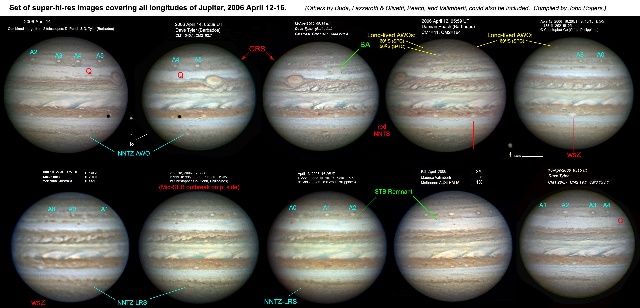
[7] S. Temperate domain: reddened oval BA, and the other circulating complex
The
colour has become even more prominent since, in an orange ring within the oval.
Now
it is about to pass the GRS.
(See
Chris Go's special web page:) http://www.redspotjr.com
The
colour in the GRS is always strongest when the SEB is faint (whitened) – as
last seen in early 1993. Although
large sectors of the STB are often faint (as now p. BA), this has long been a
common event and does not seem to
resemble the fading of the SEB. Nevertheless, it will be interesting if there
are correlated changes in the colour of oval BA and of the surrounding STB after
it passes the GRS.
It
is interesting that the reddish colour has appeared as a ring within the white
oval BA (possibly around its radius of highest wind speeds?—we await the
analysis of Hubble images). The GRS
also may have developed reddish colour first as a ring, in the 19th
century. From its discovery in 1831
up to 1856, only the light Hollow was seen.
In 1857 a dark arch appeared around its S side. Then when the SEB was
faint in 1858/59, and again in 1870, it was drawn for the first time as a dark
ring. In 1870, this was described as a 'ruddy elliptical line' by one observer
(Mayer). As he used only a 15-cm refractor, I would not trust the colour, but
this was the first mention of reddish colour in it. The reddish colour was first clearly seen, filling the Spot,
by Rosse and Copeland in 1873. I
suspect that these observations traced the true origin of red colour in the GRS,
and that oval BA may be recapitulating this development now.
(Or it may just be going through a funny phase.)
Reddish
colours on Jupiter may be associated with high vorticity, ranging from the GRS,
to tiny eddies in cyclonic 'rift'
regions in Voyager images. We still don't know
why only some anticyclonic ovals become reddish and methane-bright –especially
in the NNTZ (e.g. the present LRS, methane-bright in the Lazzarotti-Olivetti
image of April 10). Reddish colours
over belts or zones are also associated with recent energetic outbreaks (e.g. a
segment of NNTB is reddish following last year's numerous NNTBs jetstream spots,
and the NEB was recently reddish after the broadening event).
It is still not clear whether these disparate phenomena really share any
physical properties, but they all appear to involve high vorticity or high
energy in some form, and to lead to the appearance of reddish haze over the
clouds.
The
two dynamic complexes in the South Temperate domain:
In
the S. Temp. domain, the STB since 2000 has more long-lived circulations than
just oval BA. BA is part of a complex with cyclonic turbulence following it
plus another, small AWO: in white light there is a dark belt segment which
tapers southwards on the f. (W) side. On the other side of the planet, there is
a similar dark belt segment which tapers southwards on the f. (W) side; but this
second complex contains no substantial AWO.
The
arrangement is described in our BAA report for 2000/01 (as previously
referenced). At that time, the second complex was a substantial dark belt
segment, which we originally called Dark Spot 2, but that one eventually merged
with the STB f. oval BA. Then a new
little streak appeared in the vacant region of S. Temp. domain.
This new second complex is visible only as a faint blue streak (alongside
SSTemp-AWO-A1 in 2006 March, alongside A2 now in early May); but its existence
implies a long-lived cyclonic circulation still exists.
This
second complex is essentially an 'orphan' cyclonic circulation such as those
observed by the Pioneer and Voyager spacecraft (see my book p.228).
In those days, in addition to the 3 widely spaced AWOs, the orphan
cyclonic region divided the STB into four.
At other times the STB was just divided into three by the 3 AWOs.
In the late 1980s, the STB was divided into two, with one complex of AWOs
BC + DE + others, and a second complex containing oval FA (book p.221). Now the STB is again divided into two.
John Rogers, 2006 May 18